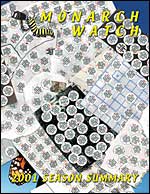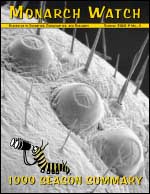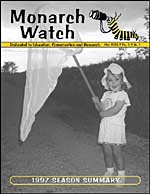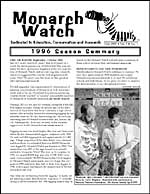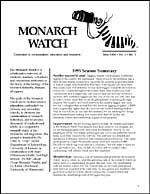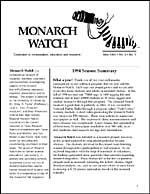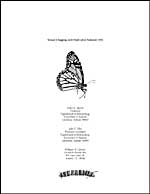 Welcome to Monarch Watch's Reading Room. Here you'll find lots of great information about monarch science and education as well as number of resources to get you started on your monarch research. |
||||||||||||
ARTICLES |
||||||||||||
|
Status Report on the Monarch Butterfly (Danaus plexippus) in Canada The Milkweeds of Canada (Asclepias spp.) Gulliver's Story Tracking Monarch Migration with Hydrogen Isotopes Conservation of Monarch Butterflies The White Monarch Snowstorm in Mexico (Winter '95-'96) Trip to Mexico Do Female Monarchs Show Egg-Laying Preferences? |
||||||||||||
MONARCH WATCH SEASON SUMMARIES |
||||||||||||
|
1992-2001 Monarch Watch Season Summary publications are available here in PDF format.
|
||||||||||||
INSECT MIGRATION STUDIES |
||||||||||||
|
Insect Migration Studies Newsletter - Fred & Norah Urquhart Volume 1 (1964) • Volume 2 (1965) • Volume 3 (1966) • Volume 4 (1967) • Volume 5 (1968) Volume 6 (1969) • Volume 7 (1970) • Volume 8 (1971) • Volume 9 (1972) • Volume 10 (1973) Volume 11 (1974) • Volume 12 (1975) • Volume 13 (1976) • Volume 14 (1977) • Volume 15 (1978) Volume 16 (1979) • Volume 17 (1980) • Volume 18 (1981) • Volume 19 (1982) • Volume 20 (1983) Volume 21 (1984) • Volume 22 (1985) • Volume 23 (1986) • Volume 24 (1987) • Volume 25 (1988) Volume 26 (1989) • Volume 27 (1990) • Volume 28 (1991) • Volume 29 (1992) • Volume 30 (1993) |
||||||||||||
SCIENTIFIC BIBLIOGRAPHY |
||||||||||||
|
The popular and scientific literature contains more than 3000 references to Monarch butterflies (L. P. Brower, pers com). This bibliography includes almost 1000 of the most important scientific papers published on this subject. The bibliography is organized by topics, but the topics are not mutually exclusive and many references appear in more than one place. Key words referring to major themes covered in the papers are given at the end of many of the references, these are intended to help you better identify the subjects discussed in the article. Although we have attempted to make this bibliography comprehensive, it is certainly not complete. If you are aware of important references which we've not listed, please send us your list and we will incorporate this information at a later date. These materials were compiled, organized and assembled by Chip Taylor, Sandra Perez and Kari Rogg.
Note: This is an archive that is not being updated at this time. MONARCH TOPICS
MILKWEED TOPICS
MONARCHS AND MILKWEED TOPICS
|
||||||||||||
CLASSROOM BIBLIOGRAPHY |
||||||||||||
|
Note: This is by no means an exhaustive list. There are literally hundreds of books about butterflies and moths, and you may find some that you like better than these. We have included a brief description of many of the books, and have only listed books that we have found useful. This list was compiled for all age groups (K-8), so some materials will not be appropriate for all classrooms. Where we have some idea about age levels, we have included that information.
Background on Butterflies and Monarchs Fiction and Picture Books Migration and Conservation Field Guides and Resources for Insect Care and Butterfly Gardening Curriculum Sources and Ideas Naturalists' Writings and Scientific Journals |
||||||||||||
FREQUENTLY ASKED QUESTIONS |
||||||||||||
|
1. How much does a Monarch weigh?
Monarchs range in mass from .25 to .75 grams (a dime has a mass of 2.3 grams). Males are usually larger than females, with average masses of .56 vs .53 grams respectively. (A good classroom question: why are males larger in both mass and wing length than females?) 2. How much does a Monarch egg weigh? A single Monarch egg has a mass of only 0.46 mg (0.00046 g), but after feeding for 15 days, a mature 5th instar (5th stage) larva can reach a mass of 1.5 g - that's 3,261 times heavier than an egg! The average pupa is 1.2 g, which represents a loss of 20% of the larval mass, but the mature adult is only 0.5 g, only 58% of pupal mass. (A good classroom question: why does the adult weigh less than the larva and pupa? What accounts for the loss in mass?) 3. How fast does the migration advance? In the midwest, we have observed that 5-6 days after masses of Monarchs assemble in Minneapolis/St. Paul (late August) the front of the migration reaches Des Moines, Iowa (4-6 Sept.) - a distance of 240 miles (360 km). It takes another 5-6 days for this wave, or front, to reach Lawrence, Kansas (usually 9-10 Sept.) - another 220 miles (330 km). However, from Lawrence, KS to Austin, TX a distance of 700 miles (1050 km), the interval varies from 6-14 days. The first masses of Monarchs usually reach the Texas/Mexico border (Eagle Pass, etc.) in the last days of September. In the midwest, if we assume the migration starts in NW Minnesota, the distance to the border is 1500 miles (2250 km). Therefore, the migration advances at roughly 50 miles (75 km) per day (1500/30 migrating days from 28 Aug. to 28 Sept.). However, these are averages, and there are reports from recoveries of tagged Monarchs which indicate flight distances up to 129 km a day. 4. How fast do individual migrating Monarchs fly? Clearly, the flight speed of such a small organism depends on environmental such as wind speed and direction relative to the heading (direction) of the butterfly. Monarchs are slow fliers relative to other butterflies and moths, flapping their wings only 5-12 times per second. Their flight speeds have been measured at 5 meters per second, 18 km or 12 miles per hour; but, if disturbed, they can fly much faster for short distances. Surprisingly, there are few data on flight speeds of Monarchs and other butterflies. This could be a good project. All that is required is an open field, a clipboard, a tape measure, a stop watch, a wind speed and direction indicator and some keen observers. 5. Do Monarchs occur outside of North America? Yes. Monarchs are found at middle elevations in many places in central and south America. Although not well studied in these areas, there are some indications that Monarchs migrate to dryer areas when the wet season begins and then back to wetter areas when the dry season becomes so severe the host plants die back. In the last century Monarchs were introduced, evidently by ship traffic, to the Azores, Australia, New Zealand, Hawaii and many Pacific islands. More recently a limited population of Monarchs has become established in southern Spain. 6. How long do adult Monarchs live? In captivity, reproductively active Monarchs can live up to 6 weeks - if they are well cared for. In the wild, the duration of the life span depends on the time of year. Summer Monarchs, which are reproductively active, probably live 2-6 weeks. The survivorship of summer Monarchs probably declines when nectar is scarce and when temperatures exceed 95 F (35 C). Generally insects live "faster" and have shorter lifespans when it is hot and dry. Monarchs which overwinter in Mexico can live up to 8 months! These Monarchs are in diapause and are not reproductively active until the end of the winter in Mexico. The cool conditions at the roost sites in Mexico, the inactivity of the butterflies and the lower metabolism during diapause, contribute to the longer lifespan of the migratory generation. 7. Do Monarchs that migrate to Mexico in the fall make the trip back to the area from which they started? After clustering in the roosts in Mexico for 5 months in the winter, Monarchs begin to make their way back north. Before leaving the roosts, they become sexually active and mate multiple times. As the female Monarchs move northward, they lay eggs on milkweed plants along their flightway. Most of the northward migrants complete their reproduction in the southern states, but each spring relatively small numbers return to the Midwest, sometimes as far north as southern Iowa. However, very few if any, reach the area from which they originated. It is generally believed that Monarchs maturing from the first eggs laid on milkweeds in the southern states in late March and early April continue the migration northward in May, eventually reaching the northern limits of the breeding grounds in central and eastern Canada. After 2-3 summer generations, Monarchs will again migrate to their winter roosts in the fall without having any previous experience with locating the roosts or "knowing" where the roosts are. How do they do this?! This is one of the mysteries of the Monarchs. 8. Why do Monarchs have only 4 legs? Monarchs actually have 6 legs like all other insects, but their two front legs are very tiny and folded up so that you cannot see them. 9. What are those things sticking out of the head and tail of Monarch caterpillars? Are they antennae? The black filaments, sometimes called tentacles, protruding from behind the head and near the end of the abdomen of the larvae are not antennae, but may serve some tactile function such as alerting the larvae when they are close to an object. Also, it seems that the filaments respond to sound; try clapping your hands or playing some music with heavy bass, and the caterpillar's filaments will "jerk" in response to the sound. Does this mean that caterpillars "hear" with these structures? Probably not, but it might be fun to do some experiments to determine how and why those caterpillars "dance" to the music. The caterpillars do have antennae that are located on the head, but they are very small and inconspicuous. 10. Where did the Monarch get its name? Early settlers who came to North America from Europe, particularly those from Holland and England, were impressed by the sight of the Monarch butterfly. So, they named it "Monarch," after King William, Prince of Orange, stateholder of Holland, and later named King of England. The monarchs' color suggested the name. From William, we get the vernacular "Billy", and hence the name "King Billy", which has also been applied to the butterfly. 11. What do adult butterflies and moths eat? Most butterflies use their proboscis (tongue) to obtain nectar from flowers. Some species obtain juices, salts and moisture from rotting fruit, mud, dung, and even dead animals, and in the American tropics there is one group, the longwings (Heliconius), that collects and digests pollen. Moths have similar feeding habits but one species laps up blood from the wounds on large animals and another feeds on the secretions from around the eyes of cattle and elephants! Surprisingly, many moths, such as the silkmoths (Saturniidae), yucca moths (Prodoxidae) and gypsy moths (Lymantriidae), do not feed as adults. In these cases, their adult lifespan is limited to a few days or at most a week. 12. How do Monarch butterflies breathe? When we breathe, oxygen goes into our lungs and is picked up by blood which carries it to cells throughout our body. Because we are relatively large, we need this complicated system. But insects are so small that tiny air tubes (called tracheae) carry air from the outside directly to body tissues. Air enters and leaves these tubes through small holes (called spiracles) on the outside of the thorax and abdomen. Spiracles are easily seen on larvae and pupae but are difficult to see on adults because they are obscured by scales. 13. Why do Monarch butterflies all have the same design on their wings? The design or pattern on the monarch's wings is genetically programed. This means that the pattern is determined by genetic rather than environmental factors. The color of our eyes and hair is genetically determined but our height and weight are partly determined by environmental factors such as the amount and quality of food we eat. The pattern on the wings of Monarchs is not influenced by the temperatures during larval and pupal development, nor the food plants upon which the larvae feed, however, the size of the adult butterflies is related to the quantity and quality of the leaves the larvae have fed on. 14. Why do Monarchs have this particular design on their wings? Colors and patterns of insects are thought to be the result of interactions of each species with their environment. Charles Darwin noted that "evolution is written on the wings of butterflies". By this statement he suggests that the colors and patterns on butterfly wings are the result of long term evolution. Is this true? Well, we don't have a complete understanding of how evolution works in these cases but there are numerous studies of butterflies which demonstrate many functions for color and pattern. For example, in some species color and pattern are used by individuals to recognize members of the same species for mating. Bright and/or contrasting colors, such as the black and orange of the Monarchs wings, warn predators that the insects are distasteful (Monarchs are distasteful to many predators due to the chemicals, cardenolides, they acquire from feeding on milkweeds) and, in some cases, dangerous (certain caterpillars with urticating hairs). These contrasting or warning colors are also the basis for mimicry in butterflies and other insects. Butterflies which are distasteful to predators usually have warning colors and patterns on the wings and these species serve as models for mimicry by other insects which are not distasteful to predators. Mimicry seems to work because the predators learn to avoid the color/pattern of the models and this avoidance gives protection to the mimics. In addition to communication within and between species, colors and black (melanic) pigment can also serve to maximize and minimize heat gain due to adsorption of infrared energy from sunlight. Insects tend to be more melanic and "hairier" in mountainous areas and far northern latitudes, where temperatures are low. Black pigments, particularly at the base of the wings, have been shown to enhance convective heat gain from the sun. Tropical species which frequent open, sunny habitats tend to be light in color while those which reside within the forest are usually darker. Within forests, darker colors can help conceal the insects from predators but some species also appear to use these colors to adsorb heat since they are often seen to "sun" themselves in patches of sunlight when temperatures are low. 15. If caterpillars can chew leaves why can't adult Monarchs do this? In the pupal or chrysalis stage, the Monarch goes through many transformations. One of the most interesting changes is the alteration of the mouthparts. In the larva, the mouthparts are designed to taste, cut, chew and ingest the leaves they feed on. During development in the pupal stage these mouthparts are modified to form a long tubular proboscis which the adults use to obtain nectar and water. These changes from chewing to sucking mouthparts during metamorphosis are unique to the Lepidoptera and Siphonaptera (fleas). Curiously, one small group of primitive moths (Micropterygidae) retains chewing mouthparts in the adults and in several other groups the mouthparts are reduced and non-functional. Why and how these changes from leaf feeding to sucking mouthparts evolved is not clear but an obvious advantage is that the adults are able to use other resources and are not dependent on their larval hostplants. Adult butterflies obtain carbohydrates and small quantities of amino acids and minerals from nectar; a sparse diet compared to the protein, lipid, carbohydrate and vitamin rich leaf materials consumed by larvae. This shift in diet from leaf to nectar feeding allows butterflies to range over broad areas. 16. How do Monarchs get those little scales on their wings and body? The scales form during the pupal stage of all Lepidoptera. This group of insects is named after the presence of scales; lepid-optera means scaly wings. Among the insects, only Lepidoptera have so many scales - their nearest relatives, caddisflies (Trichoptera), have relatively few scales. Scales are thought to be modified hairs but what would be the advantages of such modifications? It's hard to know how selection worked to make the conversions from hairs to scales but scales seem to have many advantages over hairs. In flight, scales probably lessen wind drag and may even contribute to lift. They also protect the butterflies by reducing water and heat loss and, depending on their color, they can aid in maximizing or minimizing heat gain. Scales may also reduce the amount of injury to the wing membrane. Scales usually contain pigments and the deposition of various pigments among scales in different regions of the wings give rise to the colors and patterns used for concealment, warning coloration, species recognition and thermoregulation. In some species, including Monarchs and their relatives, scales have been modified to disseminate pheromones (odors used for communication within species). 17. Do caterpillars and butterflies have bones? No. All insects have an exoskeleton, a hard covering or special skin (cuticle), which provides support and protects them from water loss. Because of their high surface to volume ratio, insects have the potential to loose water rapidly. The hard cuticle is coated with waxes (long chain hydrocarbons similar to those found in beeswax) which minimizes water loss. 18. Why do butterflies have to be in a chrysalis before they are born? Butterflies and moths have complete metamorphosis, which means they have four separate life stages: egg, larva (or caterpillar), pupa (or chrysalis in butterflies), and adult. The pupa is a special stage during which the tissues of the larva become reorganized and transformed into those of the adult butterfly. The changes from larva to adult are so extensive that they appear to require this intermediate or resting stage. 19. Why do Monarch butterflies rest in groups on branches during the migration and while they are at the roost sites in Mexico? The advantages of clustering behavior by migrating and overwintering Monarchs are not well understood. There are several possible explanations. Clustering could simply be an artifact of too many butterflies having a preference for the same type of resting spot. Or, perhaps, it's a follow-the-leader type of behavior in which some butterflies find a good spot and others join them. Temperature and predation may also influence clustering. This past fall ('95) we observed that clusters which formed late in the day appeared to be tighter on evenings with cooler temperatures. Why? Once Monarchs are on the roosts, and have cooled to ambient temperature, no heat is generated by the cluster. So, what are the advantages of such tight clusters? Is heat gain from the sun or from "shivering" the next morning greater in clusters? And, are tightly clustered Monarchs therefore able to become active earlier in the day than those Monarchs which are isolated? What about predation? Is there a "startle effect" and an improved chance of escape if predators attack a large cluster rather than a small one? Clustering could have several advantages but so far there are no studies of this behavior. This is an example of the many unanswered questions we have about insect behavior. 20. How high can a Monarch fly? Monarchs have been reported by glider pilots at 1250 meters (4062 feet - that's about 3/4 of a mile above the earth's surface!). And, commercial and military pilots have seen Monarchs at 3000-4000 meters over midwestern states in September. How do they get this high? They probably take advantage of bubbles (or columns) of warm air (thermals) just as birds do (e.g. hawks, eagles, vultures). If you watch migrating Monarchs in the fall, you can often see them shift from directional flight to one in which they circle, usually with the wings set in a fixed position. With each circle they rise and soar in a pattern which we usually associate with hawks.. At the top of the bubble or thermal they resume their directional flight. This behavior is most easily observed in the morning when wind speeds are low. Winds tend to break up the weaker thermals and displace the butterflies so the Monarchs probably only reach high altitudes under very special conditions. 21. When do the Monarchs mate and how does this affect their flight?The Monarchs that migrate to Mexico don't mate before they leave the north, but most females do mate before they leave the colonies to come north in the spring. How mating affects their flight isn't known. During mating, males transfer more material than just sperm to females - the sperm are packaged in a bundle called a spermatophore that can weigh up to 10%, but usually about 5%, of the female's total weight. This added weight might be hard to carry, but since the spermatophore is broken down and assimilated by the female it also provides her with energy. This question needs more study. 22. How do humans influence Monarchs? Unfortunately, much of our influence is bad. We spray insecticides that kill Monarchs along with pest insects and use herbicides and mowers that kill the milkweed plants the larvae feed on. We destroy prairies which have lots of good flowers for nectaring and larval foodplants. We have destroyed Monarch overwintering sites; in California, houses, parking lots, and shopping centers have been built on Monarch overwintering locations. We might even be changing the climate in ways that will hurt Monarchs and other butterflies. This is pretty depressing, but if we understand the impact we have on Monarchs, and other species, and if we chose to care about these organisms, we can minimize the negative impacts of human activity on this and other species. Conservation is one of the goals of the Monarch Watch and it is our intention to study human impacts on Monarch populations and to promote activities and policies that will ensure the continuation of Monarch migrations. 23. Besides milkweed, what do Monarchs eat? The larvae only eat plants in the milkweed family (Asclepiadaceae). There are 106 species of milkweeds in North America. Many of these species have become uncommon and some rare and endangered (Asclepias meadii) due to destruction of habitats. For more information on milkweeds see the "Milkweed Handbook" section of the home page. The adult Monarchs obtain nectar from flowers. Nectars in butterfly flowers typically contain 15% or less dissolved sugars, trace amounts of vitamins and minerals and in some cases small quantities of amino acids. Monarchs in captivity can be feed dilute sugar or honey water, diluted fruit juices and slices of fresh watermelon. For more information on the care and feeding of Monarchs see the section on "How to raise Monarchs" 24. Does the presence of flowers affect Monarch migration? Monarchs need the carbohydrates (sugars) in nectar to provide energy for day to day activities and to fuel the long migrations to and from Mexico. It is logical to assume that the quality and quantity of nectars available from various flower species along the way could have a significant impact on the Monarch population. An early freeze or a severe drought that reduces the nectar or kills flowers could have a devastating effect on the migration. However, the importance of nectar to the migration has not been studied. Rainfall and soil moisture are two of the important factors that determine the ability of plants to secrete nectar and it is possible that some of the year to year variation seen in the concentrations of Monarchs during the fall migration are due to patterns of rainfall that influence the amount of flowering and nectar secretion along the migration pathways. 25. Does pollution affect Monarch migration? We don't know. Ozone pollution has a distinct negative effect on milkweed plants and its possible that milkweeds, like other plants, pick up lead from car exhaust when they grow adjacent to well traveled roadways. The effects of lead and other airborne contaminants on Monarch survival are unknown. 26. Do the same number of butterflies come back each year? There seems to be quite a bit of variation in the numbers of butterflies that leave for Mexico each fall or return from there each spring. One of the objectives of the Monarch Watch is to correlate the data from the tagging program and observations of the migration, in combination with weather pattern data, to both short and long term changes in the size of the Monarch population. This is a long term study and such studies are needed to assess population trends and to develop a plan for the continued preservation of the Monarch migration. 27. If water gets on a monarch's wings, does their color come off? Monarchs are very good at shedding water. Rain water and mist will bead up on the wings and the water will simply fall off with the wings remaining dry. Occasionally, if Monarchs are in contact with standing water, the wings will loose their water-shedding ability and they will get wet. When this happens, the wings often become discolored but the pigments are usually not bleached out. 28. What did Monarch butterflies evolve from? Fossil moths, identified from imprints of wings, in shale and limestone deposits, date back to about 208 million years ago (early Jurassic). Butterfly fossils have been found in deposits which have been dated as 48 million years old (middle Eocene). Because butterflies have many advanced characteristics, they are thought to have evolved from moths. The fossil beds in The Florissant Fossil Beds National Monument in Colorado have produced 12 species of fossil butterflies. These fossils are thought to be 35 million years old and two species, Chlorippe wilmattae and Vanessa amerindica are so similar to modern butterflies in pattern and wing shape that they have been classified as belonging to modern genera. In fact, Vanessa amerindica is similar to the Old World Painted Lady (Vanessa indica) to the Painted Lady (Vanessa cardui) which is common in North America, Europe and northern Africa. Monarchs and other milkweed butterflies are not represented in the fossil record, so we can't be certain when they evolved, but they are part of a large family called Nymphalidae and this group was one of the earliest to appear in the fossil record. 29. Why don't the Monarch butterflies fly at night? Butterflies are diurnal insects which means they only fly during the day. We are not aware of any butterflies that fly at night. Why this is the case is not clear but butterflies are generally brightly colored and highly visual and their eyes are not designed to function under low light conditions. Moths are predominantly nocturnal (night flying) and they have what are known as "dark adapted" eyes which allow them to fly at night when light levels are extremely low. Moths are usually drab in coloration but some species are active in the daytime and curiously most of these species are brightly colored and relatively distasteful to predators. What about their eyes, are they light or dark adapted or both? Hmmm! Don't know the answer to this one and I'm not sure this has been studied. 30. Are Monarchs the only butterflies that migrate? No, actually many butterflies migrate. In fact, many of the common butterflies you are familiar with such as Painted Ladies, Red Admirals and Question Marks migrate northward each spring. Return migrations (southerly) in the fall are not well documented for these species. On a world wide basis, only Monarchs migrate to a specific overwintering site year after year. 31. How do Monarchs know when to migrate? We don't know for sure, but decreasing daylength and temperature probably provide cues. We do know that Monarchs begin to migrate when daylength begins to decline (3 min/day) in late August in the northern states and Canada. The temperatures are also decreasing at this time and the quality of the late season foodplants is changing as well. One, or perhaps an interaction of two or all, of these factors leads to the development of "reproductive diapause", a condition in which reproduction is suppressed; ovaries in females and seminal vesicles in males are undeveloped. Carbohydrates taken up in nectar are used for maintenance but are also converted to lipids which are stored in an extensive fatbody in the abdomen in Monarchs that are in diapause. Diapause is difficult to "break" in most insects. However, in Monarchs, migrant butterflies can easily be induced to become reproductive by increasing the photoperiod to 14 hrs and raising the temperature to 75-80. The conversion from diapause to females that are fully reproductive, as indicated by egg laying, can be is as little as 6 days. On the other hand, it seems to be difficult to induce diapause and there are no published accounts of the exact conditions required to produce migratory/diapausing butterflies. 32. Can Monarchs fly when it rains? No. Heavy rainfall could drive Monarchs to the ground where they would be unprotected. Just before rains begin (how do they know?), Monarchs seek shelter under overhanging vegetation. At these sites they position themselves vertically, with wings closed. In this position , even if rainfall hits them, the water runs off to the ground. |
All material on this site © Monarch Watch unless otherwise noted. Terms of use.
Monarch Watch (888) TAGGING - or - (785) 864-4441
monarch@ku.edu
